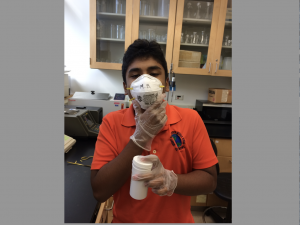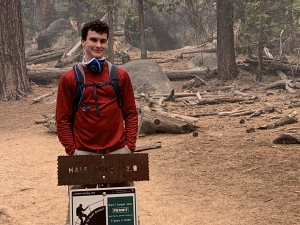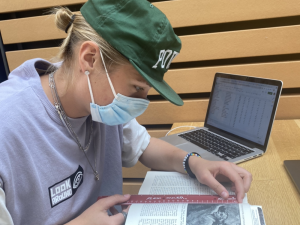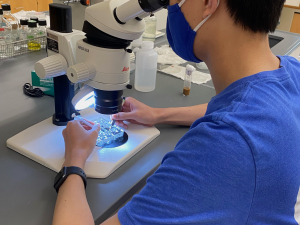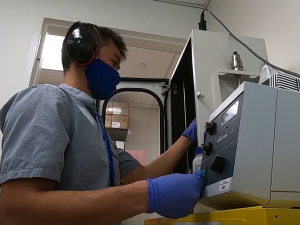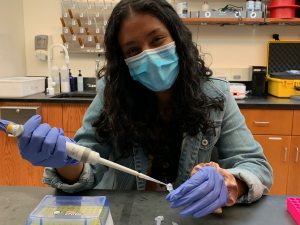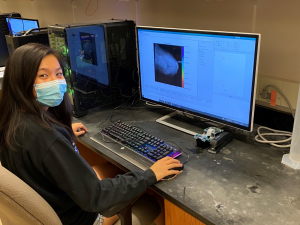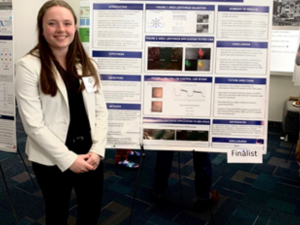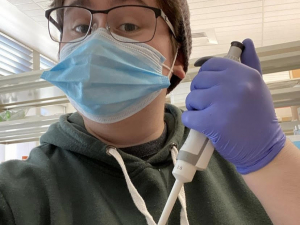Type Ia supernovae serve as "standard candles," and allow us to measure distances; this opens routes to learning more about things such as the expansion rate of the universe, to simply understanding the size and distances between cosmological objects. Furthermore, we need a comprehensive survey done of all the detectable supernovae in our local universe in order to accurately define and study the large-scale motion, or bulk motion, of clusters of galaxies towards the outer edge of our local universe; our galaxy, the Milky… read more about Exploring the Shapley Supercluster »
The proposed research project for summer 2022 was to investigate the effect of cotreating cells with HDAC inhibitors and sucrose on transfection efficiency. Initially, the plan was to treat the cells with various concentrations of sucrose and HDAC inhibitors for varying incubation periods, such as 24 hours, 48, or 72 hours, to determine an optimal combination for maximizing transfection effectiveness. To investigate this effect, experiments testing the effect of entinostat, an HDAC inhibitor, and sucrose at 10 uM… read more about Investigating the Effect of Cotreating Cells with HDAC Inhibitors and Sucrose »
This project aims to gain a better understanding of neuronal networks. Prior research has identified distinct subtypes of neurons based on morphology, gene expression, and physiologic properties. Different classes of neurons hold unique roles in cortical processing. Particularly, GABAergic interneurons, such as parvalbumin-expressing (PV) and somatostatin-expressing (SST) interneurons, are thought to have unique roles in regulating the excitatory/inhibitory (E/I) balance of neocortex. Dysfunction of such GABAergic… read more about Better Understanding Neuronal Networks »
Elevated intraocular pressure (IOP) is a major risk factor for the development of primary open-angle glaucoma (POAG), which affects more than 2.7 million Americans and is a leading cause of blindness worldwide 1. Increased IOP is mainly caused by reduced aqueous humor drainage via the conventional outflow pathway, which consists of the trabecular meshwork (TM), Schlemm’s canal, and distal vasculature 2. Increased TM contractility is associated with decreased aqueous humor drainage and can be stimulated by the activation of… read more about Research on the Rho/ROCK Pathway »
My research this summer focuses on healthcare access for African migrants in Northern and Southern Italy, to serve as the foundation for my senior thesis. This project synthesizes my interests in public health with my studies of Italian language and culture throughout my time at Duke. Additionally, I chose Italy as a site of study because of the interplay between regionalism and the public healthcare system. In Italy, there is a national health service, known as the Servizio Sanitario Nazionale (SSN), that is… read more about Healthcare Access for African Migrants in Northern and Southern Italy »
This summer, I worked in the lab of Professor Emily Derbyshire, researching the ligand-binding profile of the aryl hydrocarbon receptor (AhR) of the malaria-carrying Anopheles gambiae mosquito. AhR, a transcription factor, has been implicated in insecticide resistance in several other insect species, namely by upregulating expression of insecticide-metabolizing cytochrome p450 enzymes, and mediates the Anopheles gambiae immune response to parasites and… read more about Identifying Endogenous Ligands of AhR ligand binding domain (AhR LBD) »
The Dean’s Summer Research Fellowship Grant was a pivotal opportunity in aiding my ability to do research for my undergraduate honors thesis. With the funds provided, I was able to extend the scope of my data and collect information. To provide context, the first research question my thesis will address is how do art historical survey texts change through editions? What are the demographics of the artists included and how, if at all, does that change through time? This past spring I examined the text, Janson’s History of… read more about Data Scraping Art History Survey Texts »
Senescence is a stress-induced durable cell cycle arrest. Senescent cells accumulate with age in most tissues of humans, primates, and rodents, as well as at the sites of tissue injury and remodeling [1]. Previous studies have shown that the accumulation of senescent cells in certain tissues, including white adipose, pancreas and liver leads to type 2 diabetes and the development of non-alcoholic fatty liver disease (NAFLD) [2, 3]. Moreover, a recent report demonstrated that P16-senescent cells suppress their hepatic fatty… read more about Characterizing an in vivo Mice Model for Studying Senescence in Hepatocytes »
Wnt oncoproteins play a major role in the development of all animals. To study the signaling pathway, experiments are conducted on the Drosophila homolog, the Wingless (Wg) signaling pathway. Wg signaling can produce distinctly shaped denticles or no denticles on the ventral side of the Drosophila embryo. Repression of Shavenbaby (Svb) through Wg results in naked cuticles, but proper functioning is also dependent upon transcriptional regulation by SoxNeuro (SoxN). We are… read more about Wingless Signaling in Drosophilia »
This summer I conducted research on the Human Betterment League of North Carolina (HBLNC). This summer project serves as the foundation for my year-long thesis in the history department on this same organization. The HBLNC was an organization founded in 1947 largely by a wealthy Winston-Salem businessman, James Hanes, and Massachusetts geneticist, Clarence Gamble. In its early years, aligning with the motivation for its founding, the League sought to educate the North Carolina public and beyond on sterilization, with hopes… read more about The Human Betterment League of North Carolina and its Wide-Reaching Impacts »
As a Program II student pursuing a degree in “The Arts of Communicating Mental Health,” I am interested in using art techniques to build a social support system focusing on self-expression, self-reflection, and stress relief. My research study examines the effect of interactive art in enhancing undergraduate and medical school student’s psychological well-being by providing a space for self-reflection and self-care. In Spring 2021, I have initiated a pilot study to evaluate the undergraduate students… read more about Evaluating the Effect of Interactive Art on Medical Students’ Psychological Wellbeing »
In my DSRF-funded project, I was able to work on a study that investigates the correlations between note-taking formats, learning content, study expectations, and student learning outcomes. The debate over the “best practices” of note-taking remains inconclusive. Some have found that longhand note-taking is associated with better student learning outcomes, while others have found the opposite. In my literature-reading process, I found certain studies indicating that the relative advantages of either format… read more about Correlations between Note-Taking and Learning »
The pathology of human neurodegenerative diseases is associated with protein aggregation. This ranges from polyglutamine (polyQ) aggregation in Huntington’s Disease to beta-amyloid and tau aggregation in Alzheimer’s. Originally, the project aimed to investigate how SRCP1, a protein previously discovered by the Scaglione Lab to reduce polyQ aggregation in human cells, would affect tau protein aggregation and disease progression in a tau mouse model of Alzheimer’s Disease. The mice would have been injected at age P0… read more about Protein Aggregation in Human Neurodegenerative Diseases »
Sex biases are common among behavioral conditions that disrupt social and affective functioning, including mood disorders and autism spectrum disorders (ASD). Female-specific Reproductive Mood Disorders occur in ~18% of women during periods of reproductive transitions (premenstrual, postpartum, and menopause transition). While studies have begun to characterize relevant sex differences in isolated brain regions, few to none have identified the larger circuits involved, including peripheral-to-brain circuits. In 2018,… read more about Functional dissection of reproductive-to-brain circuits for social and affective states »
We expressed channelrhodopsin (ChR2) in three VGlut2-Cret+ and two PV-Cre+ mice through injection of an adeno-associated virus (AAV5-DIO-ChR2-eYFP) throughout the superior colliculus (SC). Specifically, we tracked three regions in the VGlut2-Cre+ mice: m5 (AP -1.68mm, ML -0.1 mm, DV 1.2mm), m40 (AP -1.68mm, ML -1.2mm, DV 1.6mm), and m42 (AP -1.68mm, ML +/- 0.2mm, DV 1.4mm) and one region in the PV-Cre+ mice: m59 (AP -1.68mm, ML 0.2mm, DV 1.2mm) and… read more about The Superior Colliculus and Head-Turning Behavior »
In time series analysis, a central theme is to look at the characteristics of the signal in the frequency domain, which can be estimated via a suitable Fourier transform. As we typically encounter just one set of data of finite length, the estimates will not be precise, and we must find the right balance between resolution, bias, and variance of the estimates. Due to the manifestation of the Heisenberg’s uncertainty principle, it is not possible to construct a perfect … read more about Time series analysis using multitaper method »
In Western music, tonal structure – the relative importance of different musical pitches and chords – is a key characteristic that creates tension and resolution, thus evoking musical emotions. The implicit recognition of tonal structure requires music to be parsed and integrated over time. While there is evidence for a specialized system analyzing temporal structure in speech3, this remains less well understood for music. The overarching goal of this study is to determine the characteristics of temporal integration… read more about Temporal Structures in Tonal and Atonal Music »
Sudden cardiac death of children and adolescents occurs principally due to variants in genes encoding cardiac ion channels that can manifest as lethal arrhythmias. Human-induced pluripotent stem cells (hiPSCs) can be used to derive cardiac myocytes (hiPSC-CMs), which serve as a valuable tool for modeling cardiac diseases and their associated arrhythmias in vitro. We intend to incorporate voltage and calcium-sensitive indicators into the genome of hiPSC-CMs to characterize repolarization and depolarization phases… read more about Lentiviral Delivery of Calcium and Voltage Optogenetic Indicators to hiPSC-CMs »
This past summer I collected data on my thesis through a Qualtrics survey. My aim was to research whether the use of classical psychedelics including psilocybin, dimethyltryptamine, 5-methoxy-N,N-dimethyltryptamine, mescaline, ayahuasca, lysergic acid diethylamide, and ketamine correlated with changes in a range of cognitive and personality variables. These included the Big Five (openness, conscientiousness, extraversion, agreeableness, neuroticism), growth mindset, empathy quotient, Machiavellian/amorality, curiosity,… read more about Impact of Classical Psychedelics on Cognitive and Personality Variables »
Inequality in Generalized Exchange explored how generalized reciprocity is impacted when people have differing resource values. Generalized reciprocity is an exchange structure in which someone has the opportunity to pay forward help they have received to someone else. First movers are those who start chains of paying-it-forward, while second movers have the opportunity to pay forward the help they may or may not have received to someone else. A primary finding was that as first movers, people who had high value resources… read more about Inequality in Generalized Exchange »
This summer, I worked with Dr. Van Cappellen to investigate the relationship between the beliefs people have about life after death and their attitudes towards people with different religious and political identities. Many people, regardless of whether they have ever been religious, hold strong beliefs about what will happen to them once they die. Although research has addressed the way that afterlife beliefs are related to internal experiences like anxiety, there is little research on how they may be related to… read more about Afterlife Beliefs and Prejudice »
For my International Comparative Studies honors thesis titled "A Magic Carpet Ride: Exploring the Latinx Community’s Contribution to the Carpet Capital of the World, Dalton, Georgia," I am examining the following questions about my hometown: How has the carpet industry in Dalton, Georgia, impacted the formation of Latinx individuals’ histories and identities, and vice versa? And how do these geographically specific experiences fit into the transnational conversation about Latinx folks in the US… read more about A Magic Carpet Ride »
Supported by Duke’s URS Summer Idea Grant, I performed transfer learning on cell segmentation models for data analysis on cardiac tissue images. My tasks for analyzing these images were to identify all cell nuclei, cardiomyocyte (CM) nuclei, and endothelial cell (EC)nuclei, as well as proliferating CMs and ECs. This is the final step in my research lab’s LVAD project, which involves determining the relationship between the use of a left ventricular assist device (LVAD) and CM and EC proliferation. I began working with… read more about Transfer Learning and Cellpose »
Some quantum field theories (QFTs) like quantum chromodynamics (the theory that governs the strong nuclear force) have an intriguing property called asymptotic freedom. When present, this feature of the QFTs allows us to understand the very high energy limit of the physical systems. I am incredibly grateful for the generous support from the URS office under the Summer IDEA Grant, which allowed me to work with Dr. Shailesh Chandrasekharan on this intriguing field of research. In particular, we studied how a… read more about Quantum Field Theories »
To me, the idea of doing something that has never been done before has always fascinated me. With this research opportunity, I had the chance to do just that: develop a novel fluorescent tool to measure a type of ubiquitination, an essential cellular process in which chains of the protein ubiquitin are attached to substrates, signaling them for various fates based on the type of ubiquitin linkage involved. K63 ubiquitination specifically plays a role in the regulation of a cell’s response to oxidative stress. Bimolecular… read more about Developing a Novel Fluorescent Tool to Monitor K63 Ubiquitin in Living Cells »
For the past two and a half years, I have been studying zebrafish notochord segmentation in the Bagnat lab. After taking Biology 201 in the fall semester of my sophomore year, I became fascinated with molecular biology and genetic engineering technology. The Bagnat lab, which specializes in zebrafish spine and gut formation, caught my attention due to its groundbreaking research in notochord and spine segmentation and its applicability to humans. In particular, I was interested in engineering new genetic tools that would… read more about Generation of a Zebrafish Transgenic Line for Manipulating Notochord Patterning »
This summer I worked on the “Block Hypergeometric Priors for Bayesian Variable Selection in Linear Models” project with Dr. Merlise Clyde. My first goal was to derive an analytic expression for Bayes factors using the truncated Compound Confluent Hypergeometric prior from “Mixtures of g-Priors in Generalized Linear Models” by Li and Clyde and using the block g-prior structure proposed by Hans et al in “Block Hyper-g Priors in Bayesian Regression.” I completed my goal to study the theoretical properties of Bayes factors… read more about Block Hypergeometric Priors for Bayesian Variable Selection in Linear Models »
The remote nature of our project meant that communication was one of the biggest aspects of the project. Effective communication was both challenging and, when we got it right, rewarding. The original plan for the project was for Autumn to conduct interviews in Kampala and Kalangala, Uganda. However, due to the pandemic, we had to change course and conduct research remotely. We employed two researchers and needed to focus on strong team building and collaboration. This new format presented several unique challenges. We had… read more about Perspectives on Genomics Research and Curative Therapies for Sickle Cell Disease in Uganda »
I started out this year working on a project in the Rajagopal Lab in which we investigated the phosphorylation barcode as a mechanism underlying biased agonism at the G protein-coupled receptor (GPCR) CXCR3. This project was started by the previous MSTP student working in the Rajagopal Lab and continued by Dylan Eiger, the MSTP student with whom which I worked throughout this past year. I really started my scientific interest and experience with this project, as I learned basic cell culture, transfection, BRET assays,… read more about Biased ligands of CXCR3 promote differential signaling mediated by the phosphorylation barcode »
My research project examined possible mechanisms related to the effects of air pollution and stress during pregnancy on the later life social behavior of mice. Previous epidemiological work has shown that mothers exposed to high levels of diesel exhaust pollution during pregnancy were more likely to have children who developed autism spectrum disorders. A similar association was found for mothers that experienced significant psychosocial stress during pregnancy. Research evaluating the effects of this form of air pollution… read more about Cross-fostering Influences the Effects of Air Pollution and Prenatal Stress on Social Behavior »


